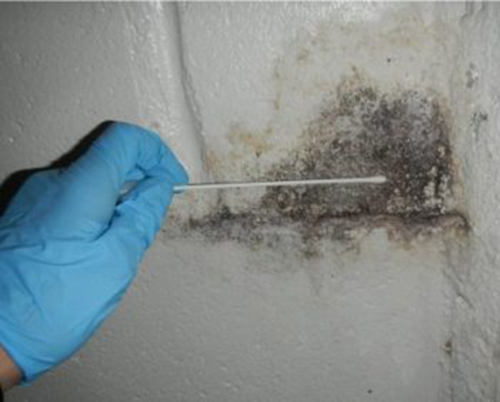Testing Air Quality After Mold Remediation
Testing Air Quality After Mold Remediation
Blog Article
Effective Article Mold Removal Solutions for Your Home
Mold and mildew development in homes can be a consistent issue, commonly needing an organized approach for efficient post-remediation options. From recognizing the elements that add to mold and mildew development to executing appropriate cleaning techniques and moisture control measures, the procedure can be complex yet vital for preserving a healthy and balanced living environment. what to do after mold remediation.
Understanding Mold And Mildew Development Aspects
The primary variable contributing to mold and mildew growth is dampness. Mold and mildew spores need moisture to prosper and germinate, making moist or moist settings highly at risk to mold and mildew problems.

Moreover, air movement and light direct exposure can impact mold and mildew growth. Areas that lack proper air flow and all-natural light are much more prone to mold and mildew advancement. By attending to these aspects comprehensively, people can properly mitigate mold growth and secure their living environments.
Correct Mold And Mildew Cleansing Techniques
Using reliable cleaning approaches is necessary in preventing the reappearance and resolving of mold contamination in interior atmospheres. The very first step in correct mold and mildew cleansing is to consist of the affected location to protect against the spread of spores to unpolluted locations.

Executing Moisture Control Measures
To effectively protect against mold growth and contamination in interior atmospheres, carrying out moisture control steps is extremely important. Furthermore, guaranteeing appropriate ventilation in locations susceptible to moisture build-up, such as kitchens and shower rooms, can assist reduce the danger of mold and mildew growth. By faithfully executing these moisture control actions, house owners can successfully lower the chance of mold recontamination and keep a healthy indoor environment.
Utilizing Natural Removal Solutions
After effectively implementing moisture control procedures to stop mold growth in interior atmospheres, property owners can now check out the efficiency of natural removal options in keeping a healthy home. Natural remediation solutions use eco-friendly methods to fight mold and mildew and mildew, making them a preferred choice for those seeking safe options. One such solution is making use of vinegar, an all-natural antimicrobial representative, to tidy and disinfect surfaces polluted by mold. Simply thin down vinegar with water and spray it onto the impacted locations, permitting it to sit for a couple of hours prior to wiping clean. Additionally, tea tree oil, recognized for its antifungal residential or commercial properties, can be blended with water and sprayed onto mold-infested surface areas to hinder more development. Another natural alternative is hydrogen peroxide, which can successfully kill mold and mildew on different surfaces without leaving dangerous residues behind. By integrating these all-natural removal options into their cleaning regimens, homeowners can effectively battle mold development while advertising a much healthier indoor environment on their own and their family members.

Maintaining a Mold-Free Environment
In order to protect against mold recurrence and ensure a continually mold-free setting, it is essential for home owners to apply aggressive maintenance techniques. Consistently inspecting locations vulnerable to mold and mildew growth, such as washrooms, basements, attic rooms, and kitchen areas, is critical. Dealing with any kind of leakages, water damage, or excess dampness promptly can considerably decrease the threat of mold growth. Post remediation mold testing near me. Proper ventilation in areas with high humidity degrees is likewise key to stop mold development. Utilizing dehumidifiers or exhaust fans can aid maintain ideal moisture degrees and discourage mold and mildew spores from flourishing.
Furthermore, maintaining tidiness in the home is important for mold avoidance. Regularly cleansing and dusting surfaces, carpets, and furniture can assist get rid of mold spores prior to they have a chance to settle and multiply. Using mold-resistant items for building products and home furnishings can better help in producing a mold-free atmosphere. Maintaining interior plants in check and making certain appropriate water drainage in outdoor landscape design can decrease dampness accumulation, lowering the possibility of mold find more and mildew invasions. By complying with these aggressive maintenance techniques, property owners can successfully support a mold-free space.
Conclusion
In conclusion, it is necessary to resolve mold and mildew development aspects, make use of appropriate cleaning methods, carry out wetness control measures, make use of natural removal services, and keep a mold-free environment in order to successfully deal with message mold removal pop over to this web-site in your house - Post Mold Remediation Report. By adhering to these techniques, you can stop mold from repeating and ensure a healthy and balanced living setting for you and your family members
The key aspect adding to mold development is moisture. Mold and mildew spores need wetness to sprout and grow, making moist or moist environments highly at risk to mold problems.To efficiently stop mold and mildew development and contamination in indoor environments, applying dampness control steps is vital. Additionally, ensuring appropriate air flow in locations susceptible to moisture buildup, such as kitchen areas and shower rooms, can help decrease the danger of mold development.After efficiently executing wetness control steps click here to read to protect against mold and mildew development in interior atmospheres, home owners can currently discover the performance of all-natural removal solutions in maintaining a healthy living space.
Report this page